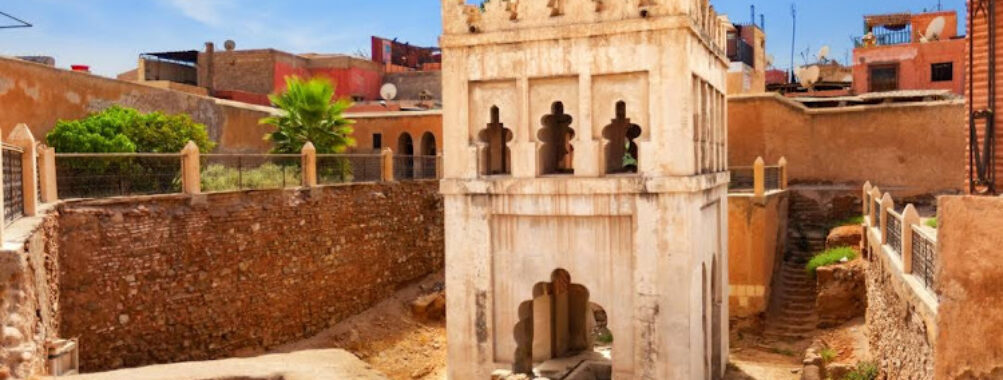
Almoravid Koubba
Table of Contents
Description
If you’re wandering through Marrakech and have even a pinch of curiosity about history and architecture, the Almoravid Koubba is a spot that quietly demands your attention. This isn’t your typical tourist trap with flashy signs and endless crowds. Nope, it’s a humble, almost secretive little gem from the 12th century—the last surviving example of Almoravid architecture in the city. Imagine stepping into a time capsule that whispers tales from nearly 900 years ago, when the Almoravid dynasty ruled a vast stretch from Spain to Senegal. This domed building, with its intricate arches and ancient stonework, stands as a rare witness to that era’s artistic and cultural sensibilities.
Now, I’ll be honest, it’s not a palace or a grand mosque that will knock your socks off with sheer size or lavish decoration. It’s more subtle, more intimate. The Koubba was likely used as an ablutions annex for a nearby mosque, which gives it this quiet, almost sacred vibe. The architecture is a fascinating blend of Berber influences and Islamic artistry, with delicate geometric patterns and carved details that make you want to lean in closer and marvel at the craftsmanship. It’s like the building itself is telling you, “Hey, I’ve been here through centuries of change, wars, and peace. Come see what I’ve got.”
One thing I really appreciate about the Almoravid Koubba is that it feels genuine. It doesn’t try too hard. It’s a spot where you can soak in history without the distractions of touristy gimmicks. Plus, it’s surprisingly kid-friendly, so if you’re traveling with little ones, they can also get a taste of history without it feeling like a bore-fest. Just a heads up, it’s a modest site, so don’t expect a sprawling museum experience, but rather a quiet, contemplative peek into Marrakech’s deep past.
Key Features
- 12th-century domed structure showcasing authentic Almoravid architecture
- Intricate geometric and floral motifs carved into stone and stucco
- One of the oldest surviving monuments in Marrakech, offering a rare glimpse into medieval Islamic design
- Small, intimate scale that invites close-up exploration and photography
- Historical significance as part of the Almoravid dynasty’s religious and cultural landscape
- Kid-friendly environment, making it accessible for families
- Located near the old medina, perfect for combining with other historic explorations
- Quiet atmosphere, ideal for visitors seeking a peaceful cultural experience away from crowds
Best Time to Visit
Timing your visit to the Almoravid Koubba can make a huge difference. Marrakech can get seriously hot in the summer months, and since the Koubba is a small, mostly indoor site, it can be a nice little refuge from the blazing sun. Spring (March to May) and autumn (September to November) are probably your best bets if you want to avoid both the scorching heat and the tourist rush. The weather is mild, and the city feels more relaxed.
Early mornings tend to be quieter, too—perfect if you want to wander around without bumping into too many people or feeling rushed. Plus, the soft morning light is fantastic for photos, highlighting the intricate details of the stone carvings. If you’re like me and enjoy a slower pace, visiting midweek can also help you dodge the weekend crowds.
How to Get There
Getting to the Almoravid Koubba is pretty straightforward once you’re in Marrakech. It’s tucked away close to the medina, so if you’re already exploring the old city, it’s just a short walk. The winding alleys of Marrakech’s medina can be a bit of a maze, but that’s part of the charm, right? Just keep your wits about you and maybe use a map app to avoid getting hopelessly lost (which, let’s be honest, happens to the best of us).
If you’re coming from outside the medina, taxis are plentiful and affordable. Just make sure to agree on a price before hopping in because bargaining is part of the game here. Another fun option is to rent a bike or scooter if you’re feeling adventurous; the city’s layout makes for an exciting ride through bustling streets and quiet corners alike.
Tips for Visiting
Alright, here’s the lowdown from someone who’s been there: the Almoravid Koubba is a small site, so don’t expect to spend hours wandering around. A good 30 to 45 minutes is usually enough to soak it all in and snap some photos. Bring a camera or smartphone with a good zoom because some of the architectural details are tiny but absolutely worth catching up close.
Since it’s a historical and religious site, dress modestly out of respect—think lightweight long sleeves and comfortable shoes that can handle a bit of uneven ground. Oh, and don’t forget a hat or sunscreen if you’re visiting during the hotter months; that Moroccan sun can sneak up on you.
One thing I noticed is that the site doesn’t have a ton of signage or guided explanations, so if you’re a history buff (or just curious), consider hiring a local guide or downloading an audio guide app. It really adds layers to the experience when you understand the stories behind those delicate carvings and the building’s purpose.
Finally, try to visit early or late in the day to avoid the midday heat and crowds. And hey, if you’re traveling with kids, the quiet and compact nature of the Koubba means they won’t get bored too quickly—win-win for parents!
In all, the Almoravid Koubba is a subtle but powerful reminder of Marrakech’s rich and layered past. It’s not flashy, but it’s genuine, and that’s what makes it stick with you long after you’ve left.
Location
Places to Stay Near Almoravid Koubba
Find and Book a Tour
Explore More Travel Guides
No reviews found! Be the first to review!